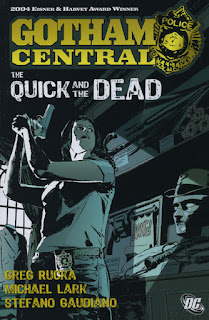Young Avengers, v. 1: Sidekicks
Collects: Young Avengers #1-6 (2005)
Released: April 2006 (Marvel)
Format: 144 pages / color / $14.99 / ISBN: 9780785120186
When Young Avengers was launched, the title was universally derided. Then, when the first issues came out, readers were surprised at the quality of the book.
Why? This series didn’t take the “young Avengers” tag too seriously or literally, and neither did the characters. Allan Heinberg wrote a Kang plot that was interesting without being confusion. He had strong, new characters that clashed with each other and with established Avengers for solid, character-based reasons. The Young Avengers had individual personalities. He even has Jessica Jones speaking exactly as her creator, Brian Michael Bendis, writes.7
 The plot for Young Avengers, v. 1: Sidekicks could have been for a six-issue mini, self contained and complete. It works both to launch a new group of characters, the so-called Young Avengers, and to make their struggle against Kang, a world-shattering supervillain, suitably impressive. They even get tied to the Avengers via a secret program of the Vision, who has done that sort of shady plotting in the past.
The plot for Young Avengers, v. 1: Sidekicks could have been for a six-issue mini, self contained and complete. It works both to launch a new group of characters, the so-called Young Avengers, and to make their struggle against Kang, a world-shattering supervillain, suitably impressive. They even get tied to the Avengers via a secret program of the Vision, who has done that sort of shady plotting in the past.
I’ve enjoyed the art of Jim Cheung ever since he teamed up with John Francis Moore on X-Force in the ‘90s. His work remains very good, detailed without being too detailed, graceful without being too perfect. However, he does tend to give everyone a very similar face — it was difficult to tell who Jessica Jones was at times — with the exception that Hulkling and Asgardian, two gay characters, have more feminine features than other male characters.
All these positives aside, this TPB was released two years ago, and the second came out soon after. That caught TPB readers up with the floppies ... and there haven't been any new issues of Young Avengers since. (Young Avengers Presents doesn't count.) This is a series that, while potentially excellent, has little momentum at all.
Rating: ![]()
![]()
![]()
![]() (4 of 5)
(4 of 5)
Labels: 4, Allan Heinberg, Jim Cheung, Kang, Marvel, Young Avengers





 Part of it is still the coloring combined with Michael Lark’s art. It’s better in this book, probably exactly the effect he and his editor was going for, but it still seems murky to me. Part of it is the skipped issues — #26-27 are omitted from the collection. Part of it is the lack of consideration toward new readers; the “helpful” list of Gotham’s Major Crime Unit personnel at the beginning of the book contains two dead men and still has two partners listed as being on different shifts. (It also is still badly organized and has only bare-bones info.) Also, in “Lights Out,” the Batsignal is taken down and cops discuss whether they should trust Batman after some act of perceived betrayal, but there’s no info on what that betrayal was and no reference even if the reader wanted to find out.
Part of it is still the coloring combined with Michael Lark’s art. It’s better in this book, probably exactly the effect he and his editor was going for, but it still seems murky to me. Part of it is the skipped issues — #26-27 are omitted from the collection. Part of it is the lack of consideration toward new readers; the “helpful” list of Gotham’s Major Crime Unit personnel at the beginning of the book contains two dead men and still has two partners listed as being on different shifts. (It also is still badly organized and has only bare-bones info.) Also, in “Lights Out,” the Batsignal is taken down and cops discuss whether they should trust Batman after some act of perceived betrayal, but there’s no info on what that betrayal was and no reference even if the reader wanted to find out. Perhaps it’s just me. But even though I know the stories in
Perhaps it’s just me. But even though I know the stories in  The Hulk has a few of his B-grade villains created in this book: Bi-Beast, Zzzax, Harpy, the Wendigo. The creation of the
The Hulk has a few of his B-grade villains created in this book: Bi-Beast, Zzzax, Harpy, the Wendigo. The creation of the  After that, a whole lot of fighting, a whole lot of arguing between Ares and Hercules, and more than few scenes of Alexander being seduced away from his family by Mikabushi, the Japanese god of Evil. The series drags on in the middle and could have stood to be shortened by an issue. The method used to justify the conclusion is barely tolerable, a loose plotline that didn’t get enough play earlier in the story.
After that, a whole lot of fighting, a whole lot of arguing between Ares and Hercules, and more than few scenes of Alexander being seduced away from his family by Mikabushi, the Japanese god of Evil. The series drags on in the middle and could have stood to be shortened by an issue. The method used to justify the conclusion is barely tolerable, a loose plotline that didn’t get enough play earlier in the story.